Rotavirus infection is an infectious intestine damage, which is often called “dirty hands” syndrome, rotaviros, intestinal flu, rotavirus enterocolitis. This pathology proceeds hard, often with serious consequences. Sometimes it leads to death if medical care was not provided. The disease combines the symptomatic paintings of two pathologies at once - food poisoning and respiratory disease. Rotavirus greatly damages the entire digestive system, leads to dehydration and toxic damage to the body. Rotavirus is especially dangerous for babies, pregnant women and the elderly. Consider what rotavirus infection is, how to distinguish it from other diseases, and how to cure this dangerous ailment.
Content
What is rotavirus infection
This disease causes a rotavirus, the name of which comes from the Latin “Rota” and translates as “wheel”, “circle”. The virus received this name due to its form: if you consider it under a microscope, it resembles a fragile wheel with a clear rim.
Rotavirus includes seven subspecies, which are denoted by Latin letters in alphabetical order from A to G. People most often affect the first subspecies - Rotavirus A. He, in turn, is divided into several series (varieties).
The virus is very resistant to hydrochloric acid and intestinal enzymes. Such protection is provided by the triple shell of the protein structure. Thanks to this, rotavirus intestinal infection, penetrating the stomach, begins to actively multiply on the mucous membrane of the internal organs.
After damage to the mucous epithelium, the virus begins to penetrate into deeper cell layers. There is a quick reproduction of the new colonies of the virus. If at this stage the immune system manages to defeat the virus and prevent it from plunging deeply enough in the tissue, the disease passes in a lightweight form without symptoms. As a result, the body produces antibodies, and a person does not even notice that he suffered a heavy ailment. Unfortunately, such cases are isolated, and an acute form of rotavirosis develops more often.
Important! The incubation period of rotavirus infection lasts from 1 to 5 days, but during this time a person is already becoming contagious.
The acute period of rotavirosis can last about a week, sometimes more than 10 days. Rotavirus can be recognized by the signs of toxic damage: indomitable vomiting, multiple bowel movements (diarrhea), food dysfunction.
Soon, the clinical picture of SARS - runny nose, lacrimation, pain in the larynx. The last signs are manifested as a result of the penetration of toxins into the bloodstream.
With good treatment, after 7 days the disease decline and after 4-5 days the patient is recovering. But in each patient, the period of illness and recovery may differ, so it is very difficult to determine how much rotavirus infection lasts. On average, the total duration of the disease is 10-14 days.
Rotavirosis develops much more often in babies than in adults. This feature lies in the fact that in an adult in the stomach, significantly more gastric juice forms, which prevents the active reproduction of the virus. And in children an immature digestive system is a very favorable environment for rotarus.
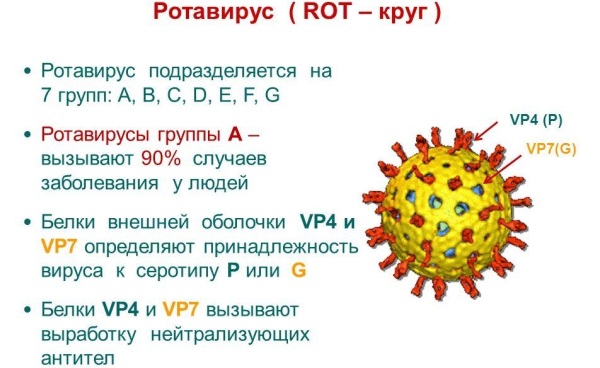
How the rotavirus infection is transmitted
Rotaviruses show unprecedented resistance to external factors, so they can exist for a long time in our environment. These microscopic viruses are able to survive under the influence of ultra -low tempera indicators, when immersed in broadcasts, formaldehyde. Even ultrasound and chlorine do not destroy the virus. The only way to kill microbe is boiling or treatment with alkaline liquids and acids.
There are several ways of infection with the virus:
- contact-household-through household items (door handle, total dishes), as well as when ignoring simple hygiene norms (dirty hands after visiting the toilet, store, unsanitary home conditions);
- alimentary is the most common path of rotavirus entering the stomach. This happens when unwashed fruits, vegetables, greens or non -fed and contaminated water;
- airborne droplets-patient with rotavirosis for a long time remains contagious. At the time of sneezing, coughing, a kiss, he transfers infection to the person with whom he is in close contact.
Viruses over a short period of time capture the enterocytes (epithelial cells) of the intestine and begin to show their pathogenic properties. Soon, after the infection, part of the healthy intestinal cells dies, and instead of them is synthesized in -fiber replacement.
The field of this fails in the process of forming enzymes, and their further work. Unformed metabolic products begin to come from the department of the small intestine into the lumen of the colon. This greatly complicates the operation of the digestive system, osmotic pressure increases and the indomitable diarrhea begins, to which other signs of rotavirus infection very quickly join.
Interesting! If during the acute phase of the patient to take a scraping from the inner ball of the stomach, then in fragments of the mucous membrane, areas affected by the virus are immediately visualized. Fortunately, we turn this process and after 1.5-2 months the digestive organs are completely restored without health consequences.
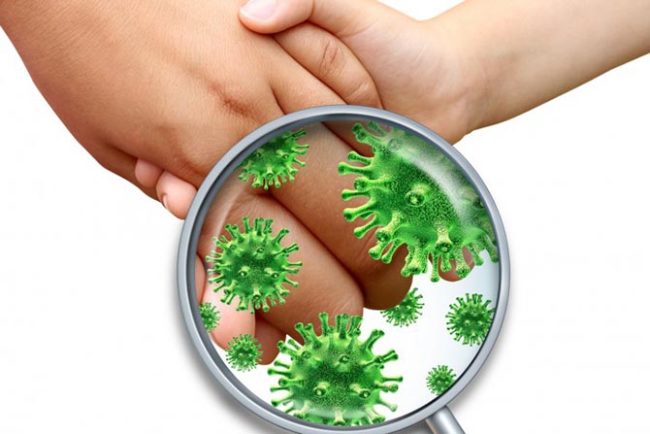
Rotavirus infection - symptoms
In different categories of the population, rotavirosis can occur with their own characteristics. For example, in babies, the acute period proceeds hard and often the disease stops in the hospital. In adults, signs are more often smoothed, and the patient can “cross” the disease on his feet, thinking that he was poisoned with something. It is especially difficult to make the correct diagnosis in women during pregnancy, since the signs of the disease are often confused with other diseases.
Signs of rotavirus infection in children
In children, especially preschool age, intestinal flu begins acutely and suddenly: the temperature (above 39 ° C) rises sharply, rapid vomiting (every 10-15 minutes) and diarrhea develops.
The chair in this period has a characteristic appearance. The first 12-24 hours it is a watery consistency, bright yellow, with an unpleasant pungent smell. Then its color acquires a yellow-gray shade, and the consistency becomes clay-like. In this case, the frequency and pain of the diarrhea attacks does not decrease.
The second characteristic group of symptoms is the picture of SARS. In children, a sudden runny nose appears, when examining the oral cavity, a plaque on the tongue is noticeable, the throat and the sky are swollen, with signs of hyperemia. There may be strong lacrimation, frequent sneezing, dry cough.
The additional features of rotavirus infection include:
- Reduced appetite or complete refusal of food. If the child manages to feed, the next bout of vomiting immediately begins. But even with prolonged starvation of the child, he tears mucus or bile.
- The pains concentrated in the abdomen are more often near the navel (this symptom can be observed in a child after rotavirus infection for several more weeks, due to damage to the pancreas and intestinal inflammation).
- Strong nausea and unpleasant sensations in the throat. The child, due to toxic poisoning, experiences nausea, a lot of saliva can be released, and as a result of constant vomiting, the esophagus and larynx suffer.
The most dangerous symptom of rotavirosis in children is dehydration. This condition is accompanied by:
- drowsiness, apathy of the child;
- anxiety and crying the baby without tears;
- dry mouth, lips and other mucous membranes;
- long absence of urination (more than 4 hours);
- pallor and sagging of the skin;
- refusal to use fluid;
- vomiting after drinking even a small amount of water.
Important! If the baby has sharply increased with a rotavirus infection, he stopped drinking, asking for a toilet and stopped responding to external stimuli, urgently call an ambulance. With prolonged dehydration, a small organism may not cope with the disease and be under the threat of death.
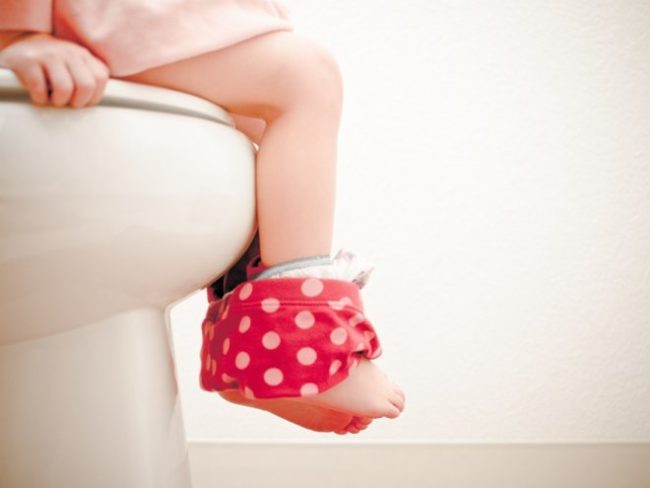
How rotavirus infection manifests itself in adults
As a rule, in an adult half of the population, rotavirosis proceeds in a more clothed form. The temperature rarely outweighs the mark of +37.8 ° C, signs of SARS can be completely absent, well -being is held at an average level of severity. The patient can complain about weakness, a ache in the body, poor appetite, drowsiness. The only brightly exposed features can be diarrhea and vomiting with rotavirus infection.
If the patient has a severe form of rotavirosis, the symptomatic picture may be as follows:
- pronounced general intoxication;
- damage to the internal organs (strong changes in the liver and pancreas are noticeable on ultrasound);
- adynamia;
- strong weakness;
- bouts of apathy;
- brown color of urine;
- hypotension as a result of cardiovascular failure;
- reduction of daily diuresis, the presence of flakes, protein in the urine;
- chair more than 15 times a day;
- indomitable vomiting, often with blood veins.
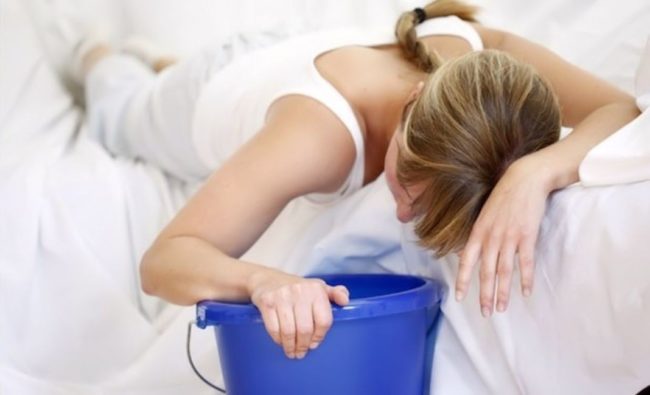
Diagnosis of rotary -Russian infection
Mostly the diagnosis is based on the patient's complaints collected and external signs of the disease. To confirm the presence of a microbe in the body and determine which rotavirus infection provoked the disease, a fecal analysis is performed - immunochromatography. The remaining laboratory studies are carried out to assess the general state of health of the patient.
Differential diagnosis of the disease is very important. Rotavirosis must be distinguished in time from similar diseases that are manifested by the same symptoms. These are cholera, salmonellosis, acute food poisoning, dysentery, cryptosporoidosis, as well as escherchiosis, intestinal yersiniosis and lambliosis.
Since in an adult, the rotavirus infection occurs in a mild form, the diagnosis is often delayed, which can cause undesirable complications if the person’s work is disturbed.
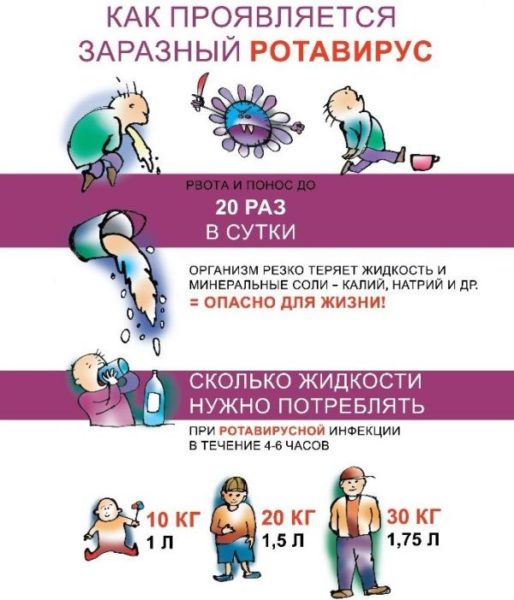
Rotavirus infection - treatment
Therapy for rotaryovirosis is the same for both babies and adults. The only differences are the prescribed dosage, dosage forms of drugs and the duration of treatment. In addition, children often undergo treatment in a hospital, since it is very difficult for parents to maintain water-salt balance, especially in infants. If an adult is diagnosed with rotavirus infection, treatment takes place at home.
Specific drugs that are able to suppress the reproduction of rotarovirus do not exist. Treatment involves maintaining the body, preventing dehydration and eliminating the most striking symptoms. To make up for a disturbed water balance and relieve the body intoxication of the patient, the patient is prescribed rehydration and detoxification treatment.
Important! Throughout the entire period of the disease, the patient is very contagious, so it is important to isolate it from society in order to prevent the spread of the virus.
To stabilize the condition, especially if the patient is a child, drug treatment is performed. The following drugs for rotavirus infection can be prescribed:
- Spasmolytics - are needed to relieve spasms in the intestines, pain relief. No-shpa, spasmalgon can be appointed.
- Antipyretic drugs - use if the temperature exceeded the mark of 38 ° C. Children are shown Nurofen, Panadol, Efferalgan, adults - Aspirin, Rinsa, Paracetamol, Codrex.
- Sorbents are a means to relieve general intoxication of the body. Smecta, white coal, enterosgel, liferan, as well as ordinary activated carbon can be used.
- Intravenous infusions - are more often shown to children when dehydration and severe damage to internal organs. Prescribe glucose with colloidal solution, the anti -shock solution of the Ringer.
- Review compositions-restore the water-salt balance with strong diarrhea, long vomiting. Prescribe a reidron, human electrolyte, Orsol, tours. These drugs are diluted in water and taken orally in small sips throughout the day.
- Antibiotics - with rotavirus infection, antibacterial drugs are ineffective, since the virus is insensitive to the antibiotic. However, in a severe course of the disease, a secondary attachment of bacterial infection and antibiotics is still prescribed. What kind of group the doctor will prescribe is difficult to assume. It depends on age, severity of complications, its localization.
- Probiotics - are prescribed after normalizing the patient's condition to restore microflora in the intestines. Usually these are Linex, Enterodermin, Narin, Lactovit and others.
- Antijearean drugs are rarely used to “not block” the release of infection outward. But to normalize the chair, enterol is prescribed. This drug is made on the basis of dry sucomycetes that penetrate the intestines and contribute to normalizing the patient's condition. In some cases, it is possible to prescribe antibacterial suspensions of a wide spectrum of action with a very long diarrhea for more than three days, for example, nifuroxazide.
Important! Antiviral agents for rotavirus infection are not effective, since there are no drugs in the strain for this strain, and all existing drugs do not affect the life of Rotarovirus.

The role of a diet for rotavirus infection
If the patient does not have appetite, no need to force him to eat. Some experts even advise to refrain from food for the first 24-36 hours so as not to load the affected digestive system. An exception may be jelly, a decoction of dried fruits.
After the acute phase has passed, you can introduce fractional power. It is forbidden to consume dairy products and meat decoctions, as well as fried dishes, sdoba, confectionery, smoked meats, marinades and other “heavy” products.
The patient needs to provide light nutrition for rotavirus infection and a strict dietary table for two weeks after cure. Preference is given to water porridge, boiled meat in the form of meatballs, vegetable stews, not welded broths (it is better to use the second broth).
It is also necessary to introduce sweet fruits, juices (not concentrated), fermented milk products. Drinking mode is important, you can use mineral water without gas. To facilitate digestion as prescribed by a doctor, you can take enzyme drugs, for example, Mezim, but not more than 14 days.
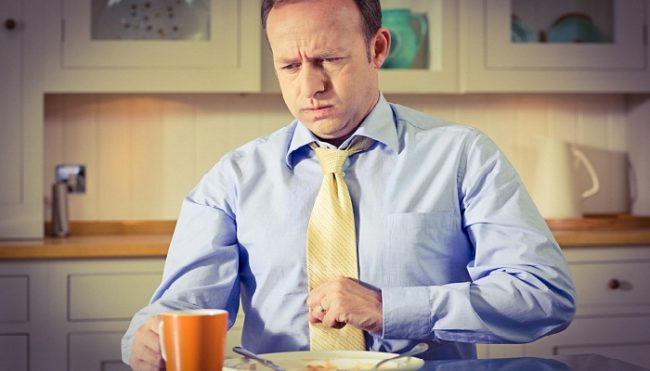
Prevention of rotavirus infection
Frequent development of rotavirus infection is observed in preschool children. They are still unable to fully adhere to hygiene rules and periodically “pick up” the virus in the kindergarten or on walks. Therefore, the prevention of re -development of the disease is especially important:
- Use only boiled water.
- If there is a patient in the house, it should be isolated for 14-18 days.
- Follow the cleanliness of the hands (they need to be washed with soap after each walk).
- Do not eat unwashed vegetables, fruits, avoid water consumption from natural sources that are not intended for this.

Rotarovirus infection can be a difficult test for a child or an unpleasant surprise for an adult. It should be perceived as a serious challenge to the body, so it should not be dismissively treated. When the first symptoms appear, be sure to contact a doctor. He will advise how to treat rotavirus infection, and if necessary, he will give a referral to the hospital where you will provide the necessary assistance.









Comments
a couple of years ago, there was no side of metrogils from the same problem, there were no side effects ...
I’m not a fan of peeling at all, it saves from acne of metrogil, it also smoothes it ...
Great article! ...
I take the second course of the Capsules Climafite 911. The tides went very quickly. It became calmer, irritability went away and I sleep well ...
i also noticed - it is worth nervous, everything immediately affects the face. Therefore, I try to avoid conflicts and unpleasant people. Of the creams, I like Miaflow from wrinkles - smoothes not only small wrinkles ...